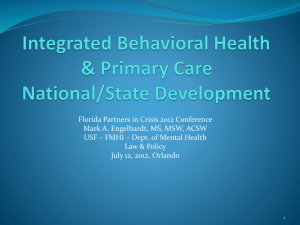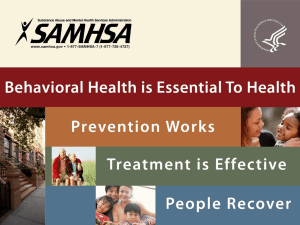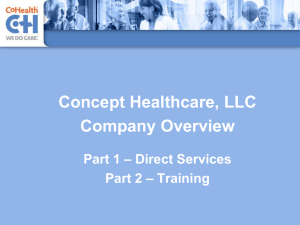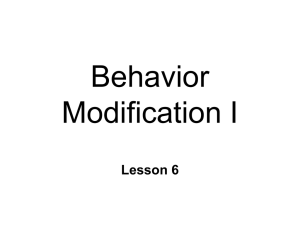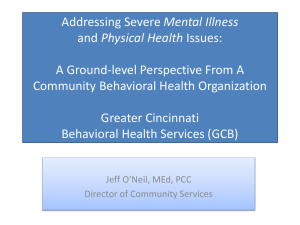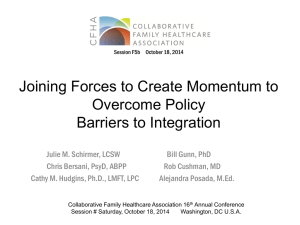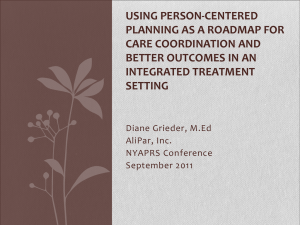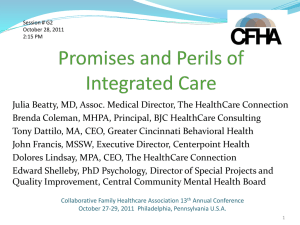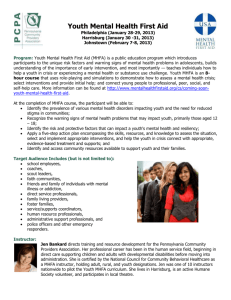Integrated Behavioral Health & Primary Care National/State
advertisement
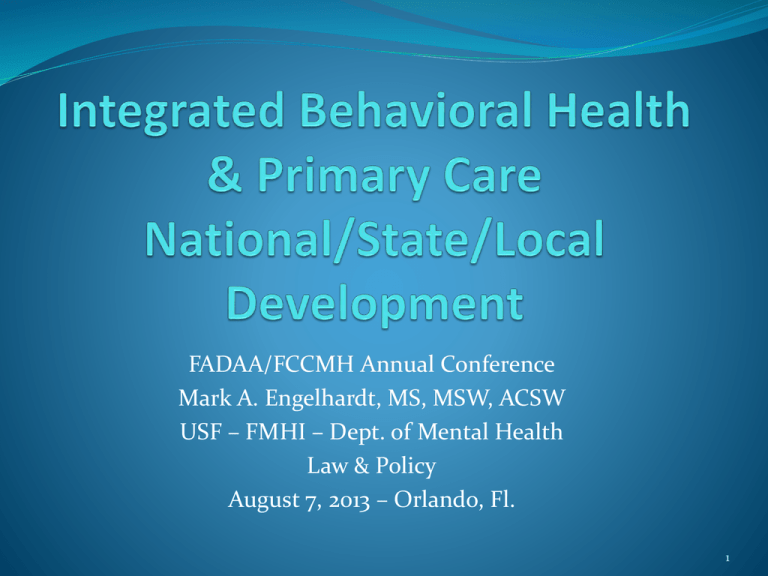
FADAA/FCCMH Annual Conference Mark A. Engelhardt, MS, MSW, ACSW USF – FMHI – Dept. of Mental Health Law & Policy August 7, 2013 – Orlando, Fl. 1 The Case for Integrated Care People with mental health and substance abuse disorders die years earlier that the average person, mostly from untreated and preventable chronic illnesses like hypertension, diabetes, obesity and cardiovascular disease. Poor health habits, such as inadequate physical activity, nutrition, smoking and substance abuse Barriers to primary healthcare & complex systems Solution – Integrated behavioral (SAMH) and primary healthcare produces better outcomes for people with complex needs involved in multiple systems of care. Quality of Integrated Care & Cost to Person/System 2 Organizational Support (2003-13) World Health Organization Substance Abuse and Mental Health Service Administration (SAMHSA) Health Resources Services Administration (HRSA) National Council for Behavioral Healthcare – Community Mental Health Centers and Integrated Substance Abuse Providers Community Health Centers – Federally Qualified Health Centers (FQHC’s) Health & Behavioral Healthcare Advocates 3 Four Quadrant Model Population Based (NCCBH) Population with low to moderate risk/complexity for both behavioral and physical health issues 2. High Behavioral health risk/complexity and low to moderate physical health risk/complexity 3. Low to moderate behavioral health risk/complexity and high physical health risk/complexity 4. High risk and complexity I for both behavioral and physical health ( SAMHSA – HRSA Grant focus) 1. 4 Integration Models (A Few) Primary Care in Behavioral Health Settings; Behavioral Health in Primary Care Settings or Bi-Directional Patient-Centered Health Homes (Approach, Not a Physical setting) – Integrated Treatment Planning Chronic Care – Disease Management Models Improving Mood – Promoting Access to Collaborative Treatment – IMPACT – Early Evidenced-based Cherokee Health Systems – Fully Integrated (Tenn.) Range: Coordinated – Co-Located – Integrated 5 SAMHSA – HRSA Solutions Target = People with Serious Mental Illnesses 94 Current SAMHSA-HRSA Primary Behavioral Health Care Integration grants Center for Integrated Health Solutions – National Technical Assistance http://www.integration.samhsa.gov Supplemental Health Information Technology (HIT) One Year Grants to supports the development of Electronic Health Records (HER) with grantees New PBHCI Grant applications to be awarded in 2014? 6 Southeast Learning Community Seven (7) Florida Grantees Miami Behavioral Health Apalachee Center – Center – Miami Community Rehabilitation Center – Jacksonville 7 Others in HHS Region Georgia = 3 Community Service Boards 4 = Kentucky (I); S.C. – State DMH; NC & TN (V) Cohorts I – V (2009-12) Tallahassee Coastal Behavioral Healthcare – Sarasota Lakeside Behavioral Healthcare – Orlando Lifestream Behavioral Healthcare – Leesburg Henderson BH (V) 7 National Outcome Measures Functioning – Wellness Healthy Overall Functioning in Everyday Life No Serious psychological distress Using Illegal Substances Not binge drinking Retained in the community Housing Stability Education and Employment Criminal Justice Involvement Perception of Care Social Connectedness Approximately 16,000 people served (To date) Positive outcomes overall 8 At Risk Criteria & Tracking Blood Pressure (130/85) Body Mass Index (Greater of equal to 25) Waist Circumference (Male – 102cm; Female 88 cm) Breath CO – ( Greater than or equal to 10) Fasting Plasma Glucose ( Greater than 100) Cholesterol (HDL less than 40; LDL, Greater than or equal to 130; Triglycerides, Greater than or equal to 150 The big one = SMOKING 9 Grantee Evaluation: Rand Corp. 56 Grantees included in the National Evaluation 67% Partnered with FQHC’s Over 16,000 served since 10/1/09 Outcome (Data), Process and Model Evaluation 78% of Grantees are urban programs in 26 states Use of Evidenced-based practices Challenges - Data, recruiting staff and consumers, licensing, info-sharing 1% arrested in past 30 days; 63% in stable housing 10 Rand Corporation Report Early Programs – SAMH in Health Care Settings Now Primary Care in SAMH Settings Common Features: Embedded Nurse, On-site Physician, Health Screenings, Illness Management & Recovery (18 Programs; Wellness Recovery Action Plans (19); Screening – Brief Intervention- & Referral to Tx (SBRIT); Peer Specialists (18); Case management Diverse Models – Clinic Based to Home visits 11 Levels of Integrated Healthcare Coordinated = Key element = Communication: usually minimal to basic coordination Co-located = Key = Physical Proximity: usually basic to close collaboration on-site Integrated = Key = Practices Change: usually close collaboration to a fully transformed/merged integrated practices – Clients experience a seamless response to all of their health and behavioral healthcare needs Heath, Wise & Reynolds March 2013 (CIHS) 12 Workforce Issues Peer Support Specialists Shared Decision Making – Person Driven Nursing – Physicians Assistants Access to Psychiatry; Outpatient SAMH Treatment Training – On-line, Certificate Programs (UMASS); Numerous Webinars; Cross-training among disciplines, attitudinal changes; case and care management models; Recovery-oriented care Recruitment and retention (Future Medicaid Expansion and Affordable Care Act) Cultural proficiency 13 Clinical Considerations Screening Tools ( I.E. SBIRT – Screening, Brief Intervention & Referral to Treatment) Health Indicators ( Substance use, tobacco, blood pressure, cholesterol, weight, nutrition, etc.) Motivational Interviewing Medication Assisted Treatment – Pharmacology Pain Management (Agency Policies) Trauma Informed Care Targeted Populations 14 PBHCI Programs Million Heart Campaign – National HHS campaign to prevent 1 Million heart attacks & strokes in 5 years Wellness programs = Strategies – Education, healthy eating, physical activity, stress management, recovery processes, peer support, diabetes management, etc. Tobacco cessation (I.E., Univ. of Colorado) Substance abuse prevention/relapse Targeted populations = homeless, drop-in centers, “housing is healthcare”, in-vivo. Interns , students, volunteers, existing programs 15 Administration & Operations Memorandum of Understanding with partners (I.E. FQHC’s) – Array of services ; who will provide what? Contracts and formal agreements: Partners Clarify Billing Opportunities and Revenue Sources – Grants, Medicaid, Medicare, Physical Health & Behavioral Healthcare – Now & Future (Affordable Healthcare Act – Prospective) Health Information Technology – Electronic Health Records – Confidentiality & Integration Meaningful Use & Data Analysis 16 COMPASS PH/BH (Cline, Minkoff) Self-assessment Tool Integrated Treatment Program Philosophy Administrative Policies Quality Improvement & Data Access to Care Screening & Identification Integrated Assessment Program & Relationships Welcoming Policies Medication Management Integrated Discharge & Transition Planning Program Collaboration & Partnerships Staff Competencies 17 Pilot Tool Kit: MTM & Zia Partners Executive Walk through Structured Prioritization from a consumer perspective Admin. Readiness Self-assessment Program Organizational Level PBHCI Capability Strategic Partnership Inventory Template Guidance on design Performance Plans with Indicators Project Planning and Organizational Templates References for Specific Materials (I.E. Tools) 18 Homeless Integrated Care Examples SAMHSA - PBHCI Grantee – Seattle, WA. – Downtown Emergency Services Center (DESC) Housing First Model Development – Pathways to Housing – PA – Primary Care Partnership with Thomas Jefferson University Dept. of Family & Community Medicine – Philadelphia Dept. of Behavioral Health & Office of Supportive Housing U.S. Dept. of Veterans Affairs – Homeless Veterans Patient Aligned Care Teams (H-PACT) – Homeless Medical Home – 23 Pilots: 37 sites funded in 2012/13 19 Contact Information mengelhardt@usf.edu 813-974-0769 (Direct Line) USF – Florida Mental Health Institute (FMHI) – Department of Mental Health, Law & Policy http://mhlp.fmhi.usf.edu www.floridatac.org Thank You 20
